Backstage with Matthew: The Art of Fashion
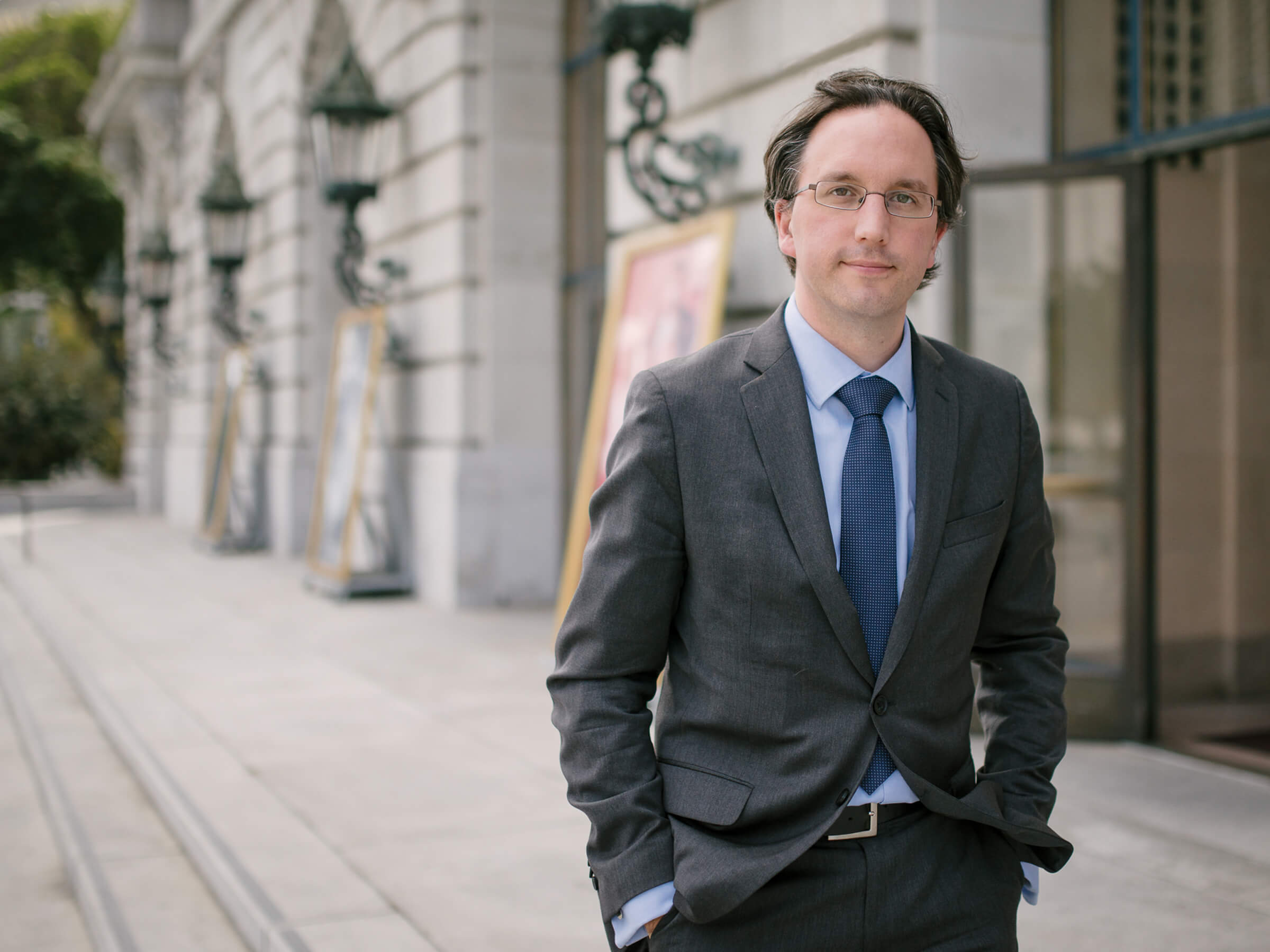
As the co-production began in Lithuania, most of the elements come to us pre-built, including the costumes. However, we are making new costumes for some of the principal characters where alterations are not possible, and that includes an extraordinary dress for the title character for Act III, scene 1—the swirling energy of the promenade of the Cours-la-Reine. Our Manon is the extraordinary soprano Ellie Dehn who has graced our stage in a number of leading roles, and in this opera moves into what I know will be a thrilling new romantic repertoire.
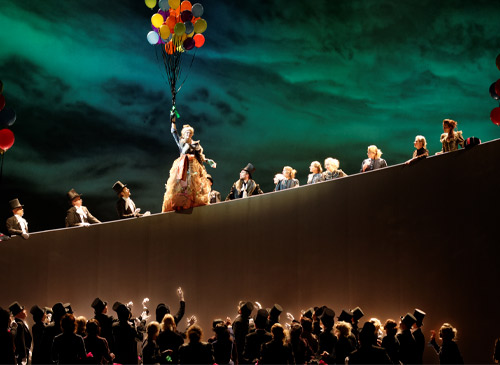
This Act III dress is very representative of Boussard’s style: an intersection of period ideas with contemporary twists. Here’s the Lithuania version of the dress showing the layering of gold netting (replete with silk and plastic ornaments), over a terracotta-colored polyester-chiffon corseted dress.
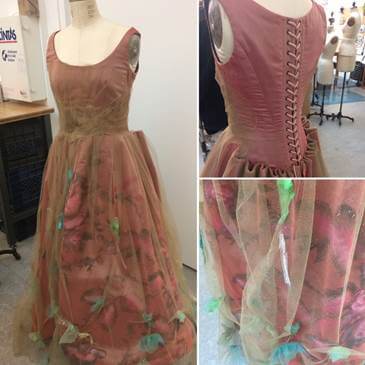
As you can see under the netting, the fabric for the dress is an exquisitely painted design, giving a richness and depth. A new version of the dress requires new painted fabric and that must all be done by hand. Thankfully we have one of the great textile painter/dyers in the business right here at San Francisco Opera—Amy Van Every. Amy’s great artistry is evident in so many of the productions we do here. She has been with the company since 1986 when she joined SFO as the lead dyer, after graduating with a BFA and working first at the Oregon Shakespeare Festival in Ashland, and the Old Globe in San Diego.
First the fabric was sourced by our costume supervisor, Kristi Johnson, who ended up finding something comparable close to home at Britex Fabrics in San Francisco. You can see the base fabric here in the bodice which is now close to completion:
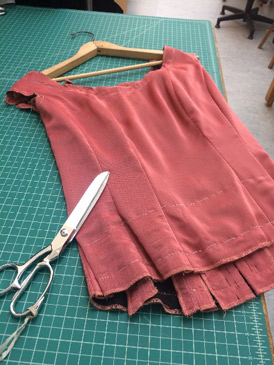
The painted polyester chiffon is attached as the skirt, and the bodice and skirt are then covered with the net. Much of Amy’s process involved determining the right paints, techniques and approaches to use. Every situation is different and requires a problem-solving approach and a process of trial and error. Even after thirty years, Amy is always experimenting, testing, mixing, adjusting, working to find the best solution for the particular fabric and design. The chemistry, the creative journey, and the skill of mixing colors together are all a huge part of the appeal of this work for Amy. She is passionate about the creative process and its iterative nature. Frequently, after fabrics are dyed and sewn into garments, they will come back to Amy for a final detailed painting or shading.
Once the fabric is stretched on a large piece of foam-core covered with Mylar (as a barrier to prevent paints and glue from seeping through and sticking to the paper), Amy then begins the painting process. She first creates stencils by laying clear Mylar over a piece of glass with a “cartoon”—the design to be created underneath the glass. For organic shapes like those on the dress, she uses a hot knife to cut out the negative space, like this cherub below. For more detailed shapes (like the lions at the end of this article), she uses an X-Acto knife to cut out the stencils. The whole design is then drawn as a cartoon underneath the fabric , and Amy then uses spray glue to attach the stencil to the fabric (for easy removal afterwards) and airbrushes the shapes with textile paint. In this example she airbrushes the black outlines, painting the pink in the center with another air-gun. Detail work is then applied by hand with acrylic paints. It’s such a detailed, multi-stepped process that has been about two weeks in the making (one of many projects Amy has on her table at the same time).
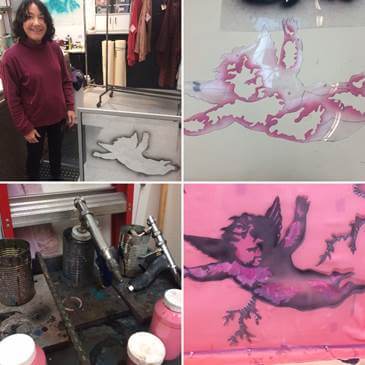
Amy was in the process of finishing up the fabric last Thursday in advance of Amy Ashton-Keller, our Master Draper, taking the fabric and creating the dress itself in advance of a fitting with Ellie Dehn next Tuesday. The gold netting won’t be applied until the fitting is complete and the dress is adjusted. The whole arc of this dress’s creation is a great example of the artistry, the craftsmanship, and the care that goes into costuming at San Francisco Opera—a level of excellence that ensures that the costumes read with depth, beauty and elegance from the house.
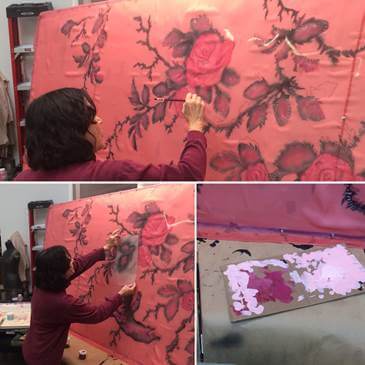
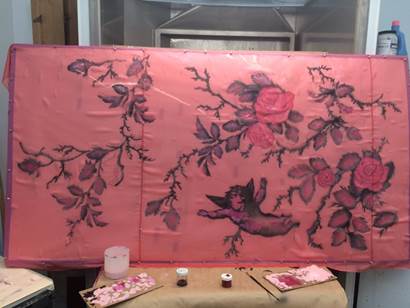
Amy and her assistants also work to dye fabrics to the correct color as specified by the designers, and that is something she’s busy at work with at the moment for our new John Adams’ opera, Girls of the Golden West. Our costume designer Rita Ryack has found some exquisite period clothes as the basis for this opera and Amy was in the process of color matching the fabric for one of Ah Sing’s dresses when I was visiting with her. The dye vats are right there in the Wilsey Center’s costume shop, and into these large steel cauldrons Amy mixes her magic, choosing from five different types of dyes, depending on the nature of the fabric and the desired outcome. These costumes must last for decades and repeated cleanings.
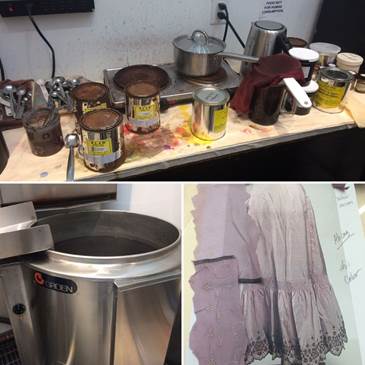
For this Gold Rush opera there are so many fabrics to dye, to distress and to age. But there are also some wonderful fabrics to paint, such as the cape Dame Shirley will wear for the Lady Macbeth soliloquy at the top of Act II. Amy showed me some of her prototyping for the lion images that will feature on the velvet cape—an example of the detailed stenciling mentioned above. You can see on the stencil the little bridges that are needed to keep the image stable—these get sponge-painted over to create texture.
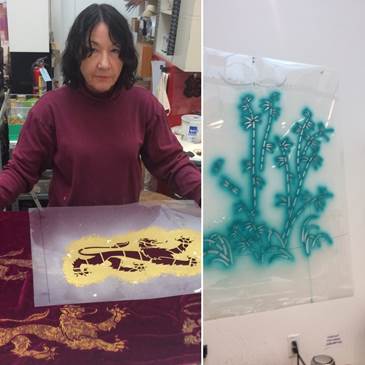
Other works in process: (l) the lion stencil and painted prototypes for one of Dame Shirley’s costumes in Girls of the Golden West; (r) one of the stencils for the Turandot costume. Below: the cartoon for the lion stencil.
When Amy began here in 1986, the Costume Shop was on Market Street between 6th and 7th Streets, with no hot water and no drying capability on the dye floor. Her new space at the Wilsey Center is a far cry from that with its gleaming dye vats and airy ceilings, but the techniques, the craft, the artistry of her work is a constant through-line, developing, mixing, creating the spectacular colors and patterns that help make the costumes on our stage such exceptional works of art. When you see Ellie’s dress in Act III of Manon, give a cheer for Amy and her colleagues in the costume shop who create these magical windows into time and place through fashion and costume.

